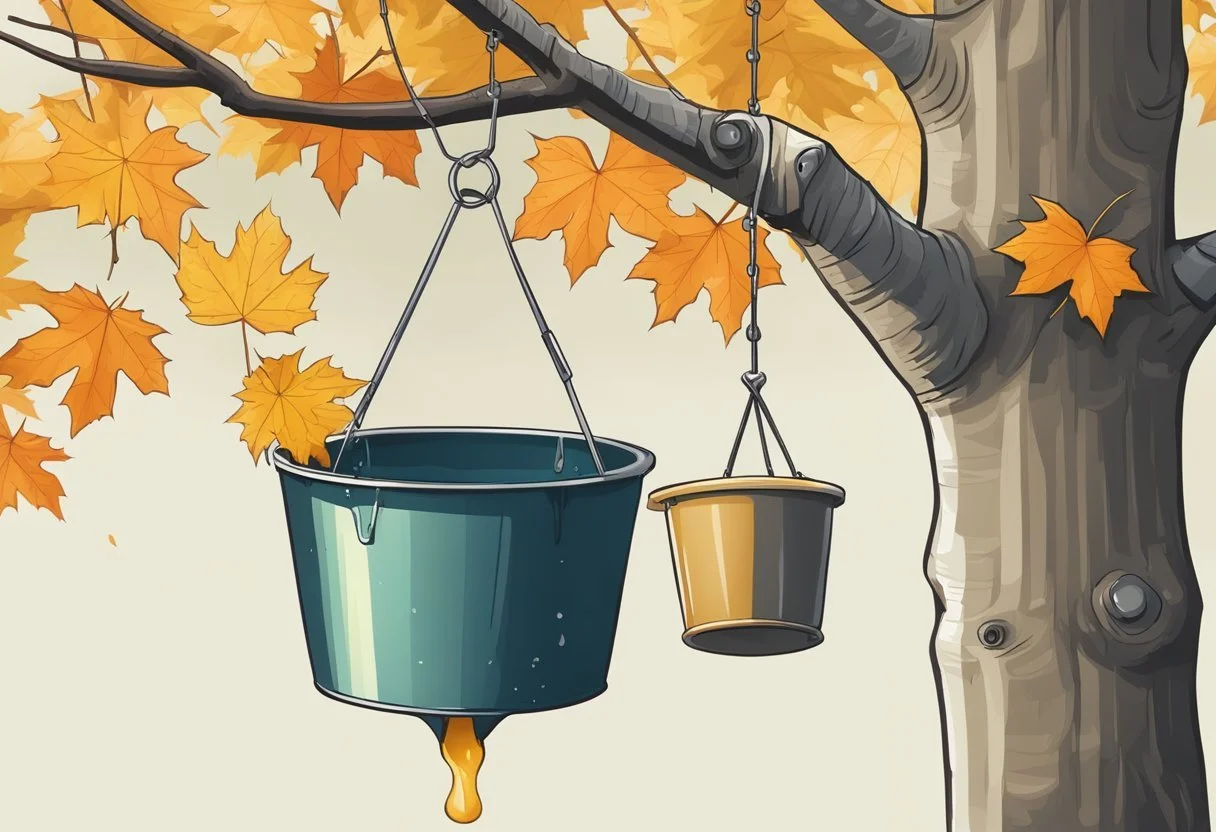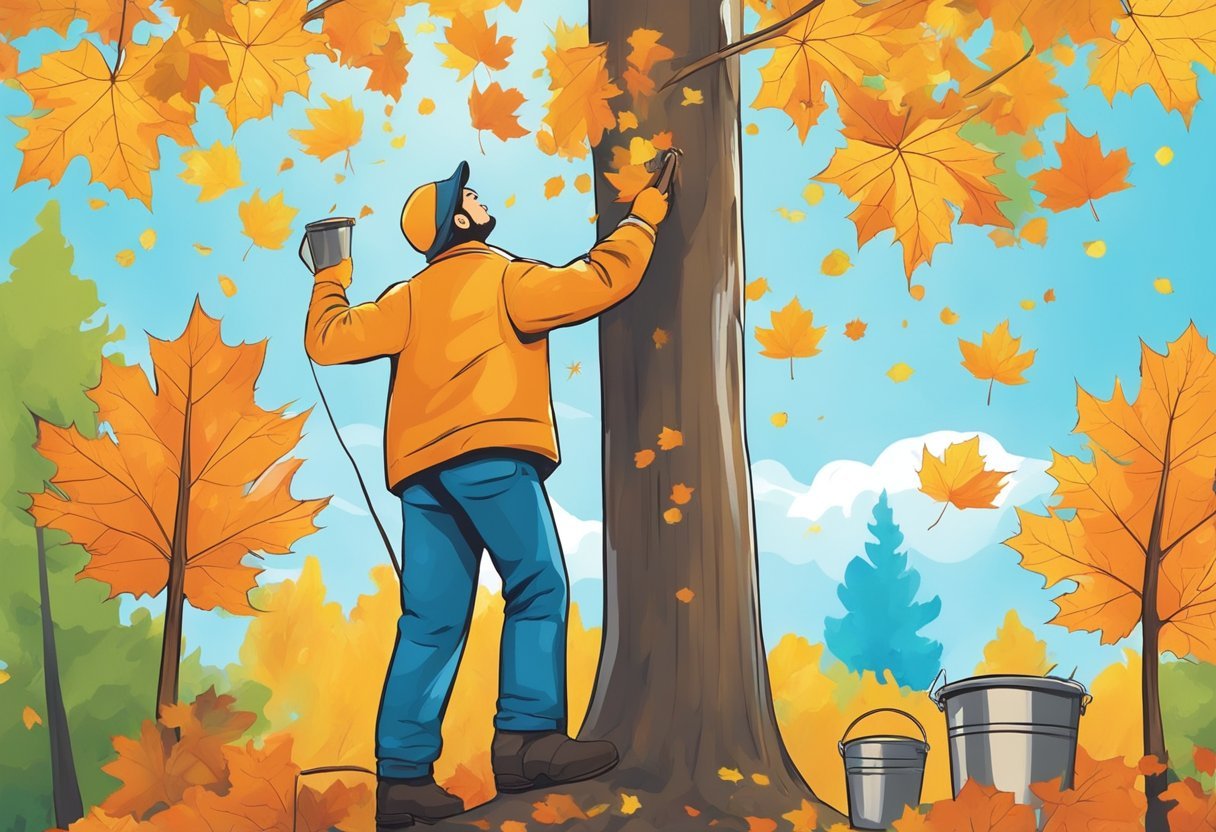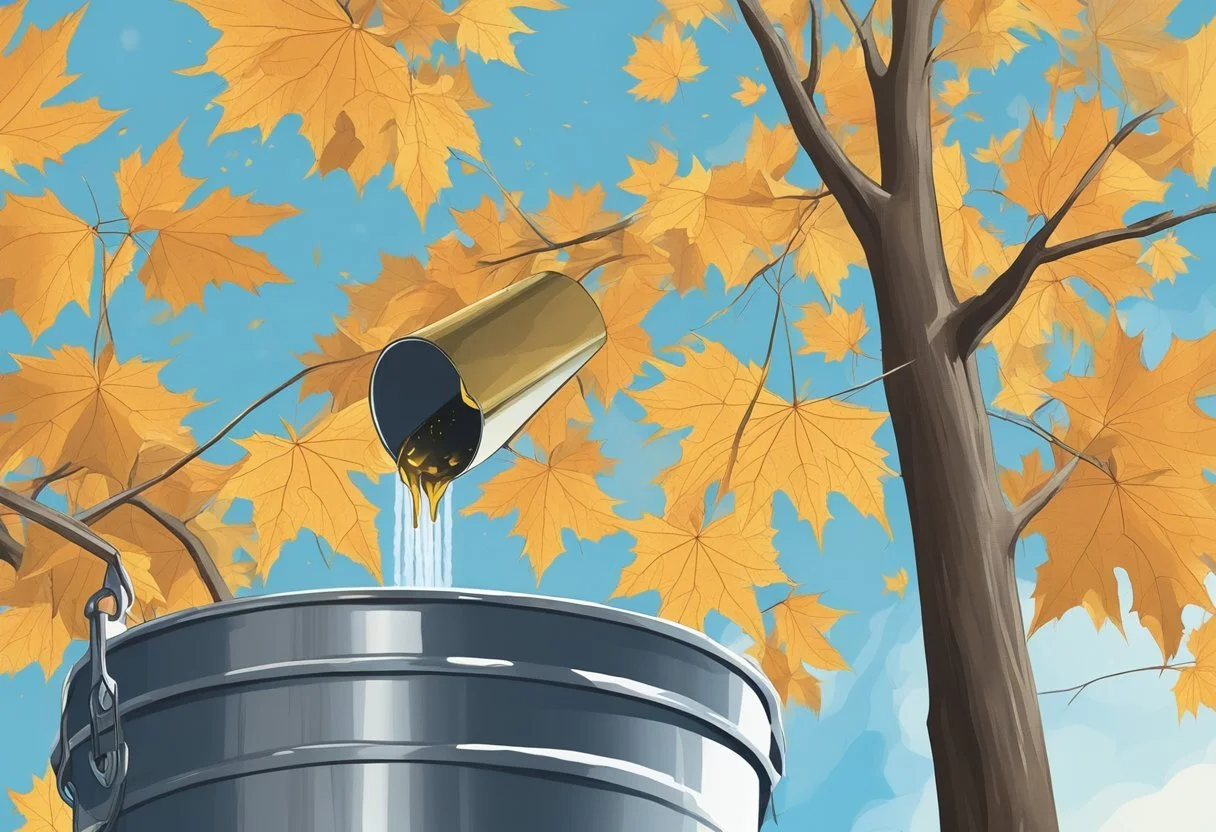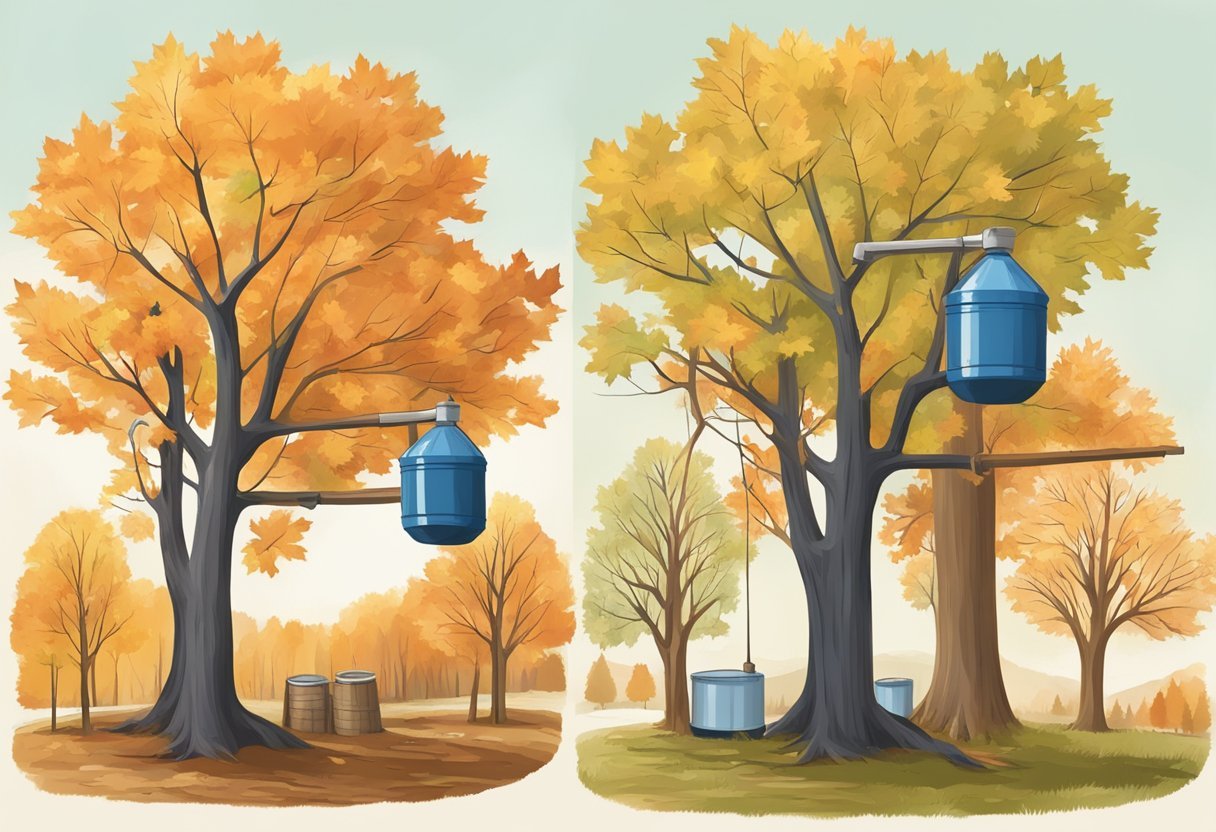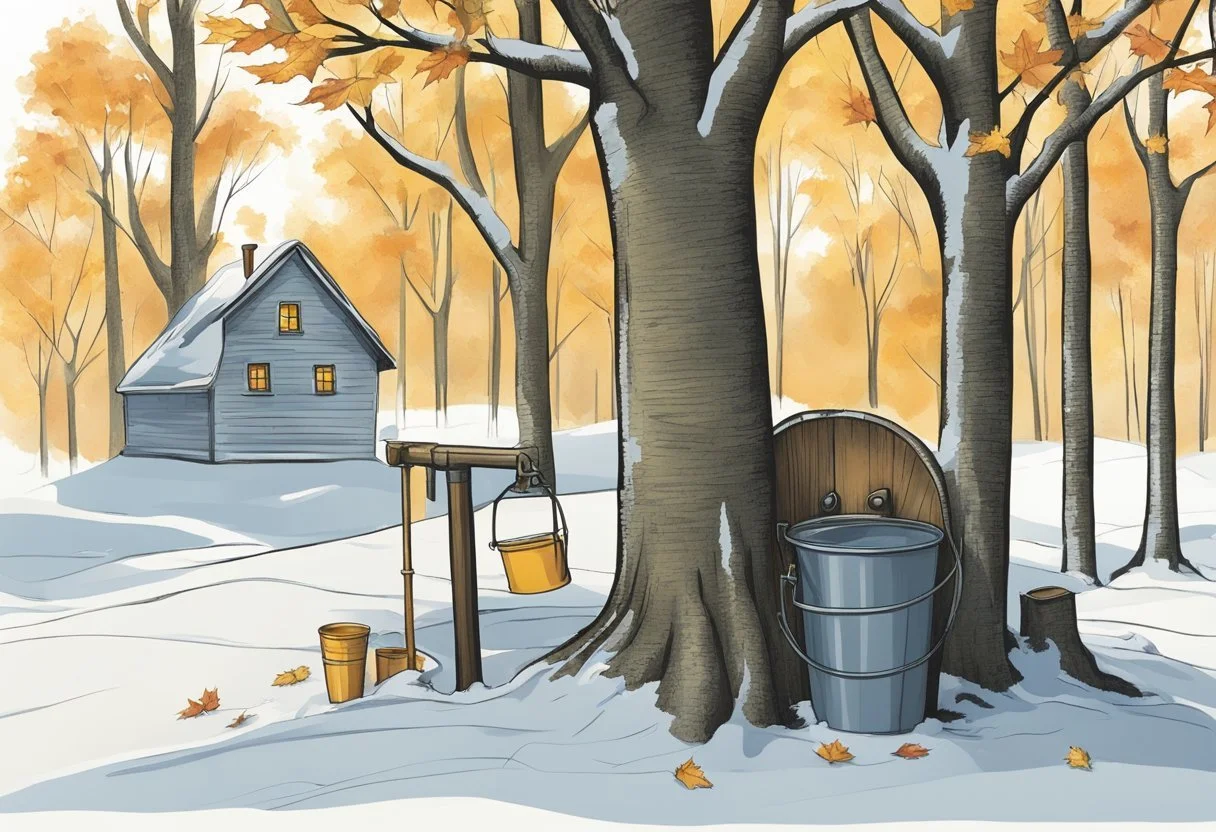Maple Tree Tapping
A Concise Guide to the Process
Discover > Homesteading > Maple Tree Tapping
Maple tree tapping is a centuries-old practice popular in North America, where sap from maple trees is extracted and turned into the delightful and versatile maple syrup (how long does maple syrup last?). If you have ever wondered where the amber-colored sweetness in your pancakes comes from, this process holds the answer. With the right tools, knowledge, and a healthy maple tree, maple tapping is an exciting and rewarding outdoor activity that can be enjoyed by both beginners and experienced tappers.
In order to successfully tap a maple tree, it is crucial to identify the right variety of maple, such as sugar (how long does sugar last?) maple, red maple, or boxelder maple, which are known to produce higher sugar concentrations. Mature trees with a minimum diameter of 12 inches that receive average to above-average sunlight exposure typically yield the most sap. The tapping season usually begins in late winter or early spring, when day and night temperatures fluctuate, creating the perfect conditions for sap to flow.
Throughout the maple tapping process, factors such as tree health, proper tapping techniques, and sap collection methods play a vital role in producing high-quality maple syrup. With a focus on sustainable practices and proper tree care, tapping maple trees can become an enjoyable annual tradition that offers a deeper connection to nature and a hands-on approach to creating a delicious, natural sweetener.
Understanding Maple Trees
Maple trees are popular deciduous trees, highly valued for their syrup production, vibrant fall colors, and ornamental value. There are several species of maples, each with unique characteristics of maple sap and uses.
Main Species of Maple Trees
There are five primary species of maples commonly used for syrup production and landscaping:
Sugar Maple (Acer saccharum): The sugar maple is the best-known and most iconic maple species. This maple sap has a high sugar content, making it perfect for syrup production. Sugar maple's fall foliage displays striking colors, ranging from red to orange or yellow.
Red Maple (Acer rubrum): The red maple is widely adaptable and showcases red, orange, or yellow leaves in the fall. While the sap of red maples can be used for syrup production, its sugar content is lower than that of sugar or black maples.
Black Maple (Acer nigrum): Closely related to the sugar maple, the black maple also produces maple sap with high sugar content. This tree's leaves are typically more lobed and droopier than sugar maple's.
Silver Maple (Acer saccharinum): As a member of the soft maples group, the silver maple has a lower sugar content in its sap. This fast-growing tree displays silver-backed leaves and is often used as a shade or ornamental tree.
Box Elder (Acer negundo): Another soft maple, the box elder has compound leaves and is less common for syrup production. This tree is often used as a shade or ornamental tree in landscapes.
Hybrids and Subspecies
In addition to the main species, hybrid maples and subspecies also exist. These trees may exhibit traits and characteristics from multiple parent species, making them unique additions to the maple family.
Process of Maple Tapping
How to Tap a Maple Tree
You have to pick the right season to tap maple trees, typically between February and mid-April. The tree sap from maples begins to flow when daytime temperatures are consistently above freezing, and evening temperatures still hover at or below 32 degrees. This period usually lasts for about four to six weeks.
Required Tools
To begin tree sap extraction, you will need the following tools:
Drill and appropriate sized drill bit for the spile
Spile (also called a sap spout)
Hammer
Thermometer
Buckets (food-grade) or sap collecting bags, as well as covers
Tubing (optional for connecting multiple taps)
Filter for straining the collected sap
Hydrometer to measure sugar content of sap
Tapping Trees
Identify a suitable tree: Choose a healthy, disease-free maple with a diameter of at least 12 inches. Trees in areas that receive plenty of water and sunlight are ideal. Sugar maples produce the highest sugar content, although red and silver maples can also be tapped.
Drill the taphole: Using the drill and drill bit, make a hole 2-4 feet above the ground, and at a slight upward angle. The drill bit size should match the diameter of your spile. As you drill, you may see some sap start to flow, or shavings come out – this is normal.
Insert the spile: Gently tap the spile into the hole using the hammer, making sure it is snug but not overtightened.
Attach sap collection container: Hang the food-grade bucket from the spile's hook or attach tubing to the spile if using a sap-collecting bag.
Sap Collection
When tapping trees make sure to check your sap collection containers regularly, especially during periods of optimal sap flow. Once the sap is collected, it's crucial to store it in a cool, dark place until you're ready to begin the boiling process. If using buckets, ensure that they have a cover to prevent debris and precipitation from entering the sap.
Making Maple Syrup
To make your own maple syrup, follow these steps:
Filter the sap: Before boiling, strain the sap through a filter to remove any debris or impurities.
Boil the sap: Start the boiling process in a large pan or an outdoor evaporator. The goal is to evaporate the water content in the sap, leaving behind the concentrated sugar.
Monitor sugar content: As the sap cooks, use the hydrometer to check the sugar content. When it reaches the desired level (approximately 66-68% sugar content), your sap has become syrup.
Store the syrup: Remove the syrup from the heat, let it cool, then strain and transfer the pure maple syrup to clean, sterilized containers for storage.
Understanding Sugar Content
Sugar content in maples plays a significant role in the quality and efficiency of sugarmaking. It is the sugar concentration in the raw sap that, when boiled, yields pure syrup. Different maple species have varying sugar content levels, affecting the amount of sap required to produce syrup.
The most prevalent species used for sugarmaking are the sugar maple (Acer saccharum) and the black maple (Acer nigrum). These two species have higher sugar content compared to other maple species. For instance, the sugar concentration in sugar maples typically ranges from 2% to 5%, whereas the red maple (Acer rubrum) usually has a lower sugar concentration around 1.5% to 3%. Sometimes natural organic salt debris can come out of solution in the syrup during heating and cooling to form sugar sand. Sugar sand is harmless and can often be removed by filtration.
It is important to note that sugar content can vary within the same species due to several factors, such as:
Tree health: Healthy, mature trees (at least 12 inches in diameter) are more likely to have higher sugar content than younger or stressed trees.
Sunlight exposure: Trees receiving adequate sunlight throughout the day tend to produce higher sugar concentrations in their sap.
Geographic location: Trees growing in certain regions may have higher or lower sugar content, depending on climate and soil conditions.
The sugar concentration in the raw sap directly affects the production of pure syrup. The higher the sugar content, the less sap required to produce syrup. For example, let's compare the amount of sap needed for one gallon of syrup:
In summary, understanding sugar content in maples is crucial for efficient and successful sugarmaking. Sugar and black maples are the ideal choices for tapping, as they boast higher sugar concentrations, resulting in a more efficient production of pure syrup compared to other species like red maple. Concrete factors like tree health, sunlight exposure, and geographic location can influence the sugar content found within the raw sap, which in turn influences the overall yield of syrup.
Maple Syrup in Different Regions
Maple Syrup in North America
Syrup production is mainly associated with North America, especially the northeastern United States and eastern Canada. The Midwest also has a notable presence in the syrup industry. Various maple species are found in these regions, with sugar maple being the most popular for sap collection due to its high sugar content.
In the northeastern US and eastern Canada, the practice of tapping maples is often referred to as a sugar bush. The season typically begins in early spring when daytime temperatures rise above freezing and nighttime temperatures dip below freezing, allowing sap to flow more readily. It's important for syrup producers to pay attention to these weather patterns as they affect the quality and quantity of sap flows.
Maple Syrup as a Home Practice
Maple syrup production or maple sugaring (how long does maple sugar last?) is not limited to large, commercial enterprises; it has become a popular backyard practice for small-scale producers and hobbyists. Tapping maples can be a rewarding endeavor for those interested in producing their own syrup and learning more about the process.
The steps involved in syrup production for small-scale producers include:
Identify an appropriate healthy tree species in your area.
Select healthy trees with a diameter of at least 12 inches (30 cm) for tapping.
Tap the tree by drilling a hole and insert a collection spile in the tap hole
Monitor the sap flow and collect sap in a bucket or other container as it flows from the tap hole.
Filter the sap to remove any debris before boiling.
Boil the sap until it reaches the desired consistency for syrup. This typically requires reducing the volume of sap by about 40 times.
Bottle the finished syrup for storage or use.
For those new to tapping maples, it's important to keep in mind that different tree species may require different amounts of sap to produce a gallon of syrup. For example, one gallon of syrup from sugar maples usually requires around 40 gallons of sap, while birch trees may require 130-150 gallons.
Impact of Maple Syrup on Economy
The maple syrup industry plays a significant role in the economies of regions where the trees are native, such as the northeastern United States and eastern Canada. In the US, maple syrup production reached a value of $125 million in 2015. This agricultural sector provides employment and income for many local producers and rural communities for the best maple syrup.
Maple syrup production is heavily reliant on specific weather conditions. The tapping season occurs during the late winter and early spring when temperatures fluctuate above and below freezing. This prompts the sap to flow within the maples, enabling it to be collected and processed into maple syrup. As such, climate change poses a significant threat to the industry, as warming temperatures and changes in precipitation patterns can impact the viability of maple syrup production.
The following table highlights some key figures of the maple syrup economy:
Note that the economic figures also consider related industries such as maple product processing, equipment manufacturing, and tourism activities centered around maple syrup.
To adapt to the challenges posed by climate change, the maple syrup industry has implemented several strategies, such as the use of advanced tapping technologies and expanding production into cooler northern regions. Despite these efforts, the future of the maple syrup industry remains uncertain due to the unpredictable effects of global warming.
In summary, the maple syrup industry is an important economic driver for regions with native maple tree populations. However, the industry faces significant challenges related to climate change, which may impact the long-term viability of maple syrup production.
Appendix: Other Maple Tree Products
Sugarmaking and its Subproducts
Sugarmaking is the process of extracting sap from maples and boiling it down to create various products. The most well-known of these is maple syrup, but other subproducts can be derived from the process as well.
For instance, maple sugar can be made by further heating and stirring maple syrup until its water content evaporates, leaving behind granulated sugar. This natural sugar has a unique flavor and can be used as a substitute for white sugar. Similarly, when sugar concentration reaches about 80%, maple cream or butter can be produced by cooling and mixing this thicker syrup variant.
Various Maple Tree Uses
Beyond sugarmaking, different parts of maples offer various uses, such as the following:
Seed dispersal: Maples produce winged seeds called samaras, which are spread by wind and carry the potential for new tree growth.
Wood: Maple wood is known for its durability and attractiveness. It is often used for flooring, cabinetry, furniture, and musical instruments like violins and guitar necks.
Ornamental trees: Some species of maple, like the Japanese maple, are grown for their decorative value in horticulture. With unique leaf shapes and brilliant fall foliage, they make beautiful additions to gardens and landscapes.
Health Implications
Maple products offer some beneficial health implications. For example:
Low glycemic index: Maple syrup has a lower glycemic index than some other traditional sweeteners, making it a healthier alternative.
Antioxidant properties: Research has shown that maple syrup contains antioxidants that can help reduce inflammation and maintain overall health.
Minerals and vitamins: Maple syrup provides small amounts of essential nutrients such as calcium, potassium, zinc, and manganese.
Overall, while maple tree products offer a variety of uses in cuisine, woodworking, and horticulture, their consumption should be moderated due to their sugar content.

